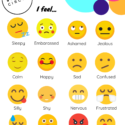We’ve all seen it – mouth ajar, guttural wailing, tears streaming down bright pink cheeks. Your kid is a mess and no one knows what to do about it.
Alyssa and Emily of Social Circle, a Toronto based business that helps make parenting and being a kid a little bit easier and loads more fun, share simple, effective ways to help children be in touch with their emotions. They have created an easy to use yet powerful tool that enables kids to notice, acknowledge, express (appropriately) and control their feelings, which means great bonding opportunities, a boost in emotional intelligence and the development of mutual respect. Click here for the downloadable chart.
When to Use It
In The Moment
Sometimes just identifying the feeling helps diffuse it. When your child is showing signs of having a big feeling (anger, frustration) ask them to point to the feeling on the chart.
Check in & Connect
As an easy way to connect, during dinner or bedtime, ask your child how their day was and how they’re feeling by pointing to the feeling(s) on the chart.
Teach Feelings Through a Game
If you’re looking for an easy activity, grab anything that could be a marker – coins, buttons, or candies. Players take turns placing their markers on different emojis. Each time they do, they must share a time they felt this way or something that makes them feel this way. The object of the game is to get 4 markers in a row, and to block other participants.
How to Respond
Remind your child that it’s okay to have multiple feelings at once, all are completely valid, and welcome – it’s what we do with them that makes ALL the difference. Validate that feeling “I understand you’re feeling sad.” and demonstrate empathy “I feel sad when I can’t see my friends, too” before problem solving or directing behaviour. We suggest printing and placing this chart in a few areas of your house so they are easily accessible.






